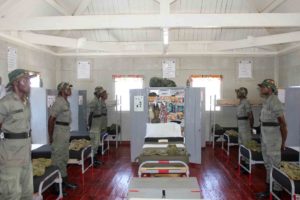Newcastle Base
| Nestled in the cool hills of upper St. Andrew and amidst beautiful trees, ferns, ground orchids, delicate wildflowers and a profusion of ginger lilies, is the Newcastle Training Depot. Its story is intertwined with the Jamaican tour of duty of Field Marshal Sir William Gomm. He was, incidentally, Britain’s longest ever serving soldier, having been an ensign at the age of 10 and Constable of the Tower of London over 80 years later at the time of his death in 1875. The idea of establishing a military barracks in the hills of St Andrew was proposed by Gomm, then, as a Major General, Commander of Her Majesty’s forces in Jamaica. In a letter shortly after his arrival in Jamaica, Gomm expressed great concern to the Governor at the high mortality rate among European troops in Kingston. The death rate due to yellow fever in the first half of the 19th century was one soldier every two and a half days; 1838 was a good year with only 91 men dying! In 1839, the number rose again to 110, and to 121 in 1840. This situation, common to the West Indies generally, was so desperate that when the renowned Royal Scots were warned for duty in the West Indies, the officers drew lots as to who would go. It was generally accepted that such a posting was virtually a soldier’s death sentence. Gomm dispatched letter after letter to the British government seeking the authority and finances to start construction of barracks in Newcastle. Initially, these pleas fell on deaf ears as the British government, worried about the expense, persistently ignored the dangerous and cruel loss in manpower resulting from yellow fever. Eventually, Gomm acted on his own, knowing that he had the approval of the Governor. Without British Government consent he started construction early in 1841 at the Newcastle coffee plantation. In December 1841 the Board of Ordnance authorized erection of a permanent barrack at Newcastle to house a battalion. Gomm had at last won his battle. In 1842, very soon after Newcastle was established, only 24 of 197 troops died there. Five years later only seven men died from a strength of 583, and in 1853, a mere two men perished out of 476. Today, the visible memorials of that era – and of the relatively small number of soldiers who died there – are two immaculately maintained small cemeteries in Newcastle. From its founding until 1959, Newcastle was used by both British and (during World War II) Canadian regiments serving in Jamaica as a change-of-air camp. Some regiments moved to the hills completely, while others would rotate companies during the year. Others merely sent cadres for training at Newcastle. In 1959 the famous old West India Regiment was re-formed and Newcastle became the Federal Defence Force Training Depot, training recruits from all over the newly formed West Indies Federation. In 1962, when the unsuccessful Federation was dissolved, the Regiment was disbanded. Jamaica simultaneously sought her Independence, which was achieved on 6 August 1962. Newcastle was given to the Jamaican Government by Britain as part of a general settlement of all military lands in Jamaica. Following Jamaica’s Independence in 1962, Newcastle became the Jamaica Defence Force (JDF) Training Depot. Monuments Apart from the Royal Scots Monument which has already been dealt with in the history, there are the following graves and monuments. There are graves of two soldiers buried near Woodcutter’s Gap. These soldiers died of fever in the early years of the century. It is not known exactly why they were buried there, but contamination is thought to be the reason the graves can only be seen by bumps in the ground now. There are various soldiers’ graves in a small cemetery at Clifton Mount. This was used during the 1867 epidemic, and Clifton Mount was the hospital there. It is not known exactly how many soldiers were buried there, because the full records have been lost. The grave in the garden of Race Course, is of a dog buried by its owner, a Lieutenant Dent of the Royal Artillery in 1907. The grave outside the stables is of a mule buried in 1936. There are also the graves of Mr. and Mrs. Charles Hicks, buried just below the lower single Officers’ hut below the Officers’ Mess. Although only a large mound can now be seen. As can be noted from the history Mr. & Mrs. Charles Hicks were the owners of Newcastle plantation just before the army purchased the land. Regimental Badges The practice of putting Regimental Badges on the wall by the square began with the 64th Regiment in 1885. This was followed by the Royal Artillery later that century, (the date of 1655 on their badge is the first date of British Control in Jamaica). Then in 1929 the West Yorkshire Regiment started the pattern properly, from then no break until the present day. In 1959, an Old Sapper Badge was moved from elsewhere and placed on top of all the badges, and 1841 inscribed on each side of the badge. Also about that time, the Royal Sussex Badge was put up with the dates, 1919 – 21, this gives the false impression that there is a gap between 1921 – 29. The Royal Army Service Corps, Queen Alexander’s Royal Army Nursing Corps, and the Womens’ Royal Corps Badge were placed in 1938 and in 1962 respectively. These Corps never served here as a unit in any period of the history. However, these badges help to complete a unique display of British Army Badges. |
|







